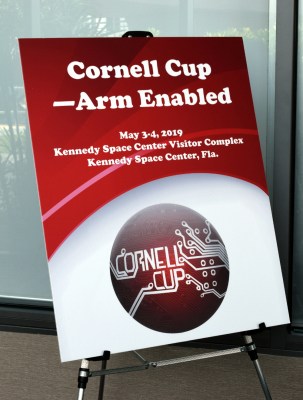For college-aged engineers and designers, finding a problem they’re truly passionate about early on could very well set the trajectory for an entire career. This is precisely the goal of the Cornell Cup, a competition that tasks applicants with solving a real-world problem in a unique and interesting way. From what we saw this is definitely working, as teams showed up with ornithopter-based quadcopters, robotic dinghies, forest fire sniffers, and high-jumping rovers.
With such an open ended approach, individual entries have a tendency to vary wildly, running the gamut from autonomous vehicles to assistive technology. No team feels pressured to pursue a project they aren’t truly invested in, and everyone’s the better for it.
Given such lofty goals, Hackaday was proud to sponsor the 2019 Cornell Cup. Especially as it so closely aligns with the product design focus of this year’s Hackaday Prize. Designing something which solves a real-world problem is definitely part of the formula when the goal is to reach large scale production. And after seeing the entries first-hand during the Finals at Kennedy Space Center, we think every one of them would be a fantastic entry into the Hackaday Prize.
I don’t envy the judges who ultimately had to narrow it down to just a few teams to take home their share of the nearly $20,000 awarded. Join me after the break for a closer look at the projects that ended up coming out on top.
First Place: S.S. MAPR
Developed by a team from the University of Pennsylvania, the S.S. MAPR impressed on multiple fronts. It was the only autonomous vehicle to make it into the Finals, and also the only watercraft. Its imposing eight-foot length was also hard to discount in a room largely dominated by tabletop demonstrations. Given its size, there was unfortunately no way for the autonomous boat to show off its moves indoors, but videos recorded during a previous expedition to Pennsylvania’s Schuylkill river were on display for the judges to view.
The team’s goal with S.S. MAPR was to make performing water quality samples faster and cheaper than sending a human out to do it, which in turn helps authorities identify and respond to ecological threats to drinking water sources. Operators provide the locations and depths they want to sample, and the craft uses a submersible pump to bring samples aboard. The 250 mL sample containers are held within a novel rotary mechanism, and there’s a provision for purging the pump and lead hose before sample collection to avoid cross-contamination with the previous sample.
Initially, the team planned to manufacture their own hull, but eventually found it made more sense to use a commercially available inflatable boat as a starting point. For propulsion, they used Blue Robotics T200 thrusters capable of delivering 5.1 kilograms of thrust each; more than enough to get the lightweight inflatable craft where it needs to go. The considerable energy requirements of the craft did prove to be something of a challenge, and …read more
Source:: Hackaday

